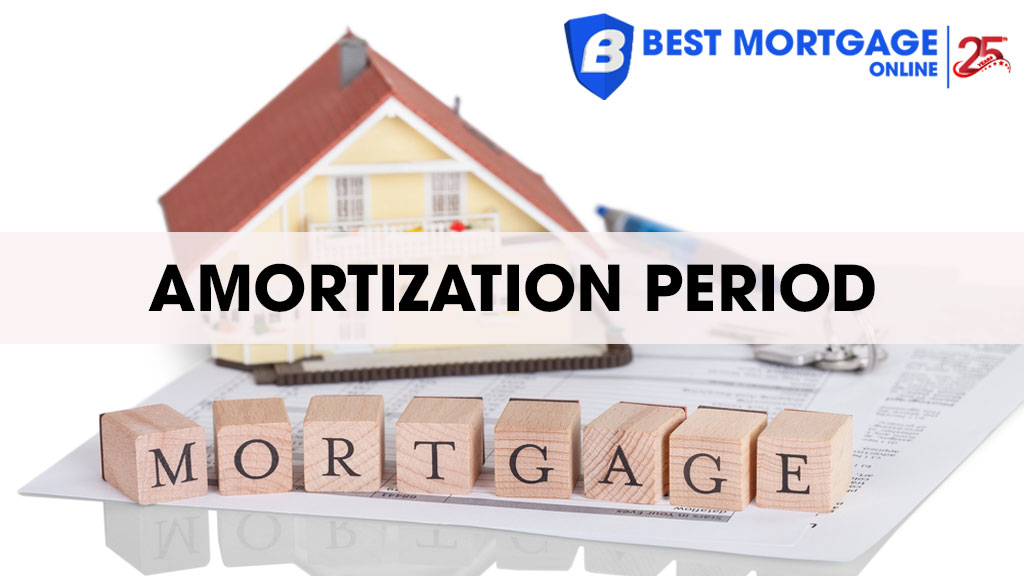One of the most critical elements of optimizing your mortgage is carefully determining the appropriate amortization period. Your decisions can save or cost you tens of thousands of dollars over the decades it takes to pay off your home.
This guide will cover everything you need to know about mortgage amortization in Canada, including how to choose the optimal schedule for your situation, the benefits of shorter vs. longer amortization periods, and expert strategies to pay off your mortgage faster.
Understanding how to manage mortgage amortization strategically will help you make the most financially savvy home financing decisions and ensure your long-term financial security. Let’s dive in!
What is mortgage amortization?
Mortgage amortization refers to the gradual repayment of the loan amount through scheduled principal and interest payments over a defined period, until the balance is fully paid off.
The total amortization period is calculated based on the original mortgage amount, mortgage rate, and the lender’s payment schedule. It represents the entire time scheduled to repay the loan fully.
Once your lender sets an amortization period, it does not change over the life of the mortgage, even if market interest rates fluctuate or you renew your mortgage. However, you can shorten your amortization schedule by making additional lump-sum payments to pay the principal faster.
What are common mortgage amortization periods in Canada?

One of the first decisions when choosing an amortization schedule is whether to opt for a shorter or longer amortization period. Typical mortgage amortization periods offered in Canada include:
Short amortization period
- 15-20 years: Very short amortization schedule. Offer lower interest and a quicker payoff period, but the trade-off is higher monthly payments.
- 20-25 years: Higher payments but build equity faster and reduce total interest costs.
- 25 years: The most common short amortization schedule. Maximum amortization period allowed for mortgages with less than 20% down payment. Canada Mortgage and Housing Corporation (CMHC) provides mortgage insurance for up to 25 years of amortization periods.
Longer amortization period
- 30 years: The most common long amortization schedule. It allows lower monthly payments but higher lifetime interest costs.
- 35 to 40 years: Extended amortization periods offered by some lenders. It reduces monthly costs but significantly increases the total interest paid.
- 40+ years: Rarely offered ultra-long amortization schedules. It is only approved for unique cases with substantial down payments. Drastically increases total interest over the mortgage lifetime.
When to choose a longer vs shorter amortization period
Follow this step-by-step process when determining the optimal mortgage amortization period for your situation:
Step 1: Consider your long-term financial goals and budget – Would a higher or lower monthly payment fit better over the decades?
- Shorter amortizations require a higher monthly payment
- Longer terms allow lower monthly payments.
Step 2: Estimate total interest costs for various amortization periods to compare lifetime costs.
- Shorter schedules have significantly lower total interest paid
- Longer terms increase lifetime interest costs
Using the $400,000 mortgage example:
| Amortization period | Total interest paid |
|---|---|
| 25 years | $186,358 |
| 30 years | $229,853 |
| 35 years | $276,690 |
| 40 years | $324,412 |
Step 3: Evaluate your down payment amount; if it is less than 20%, the maximum amortization is 25 years.
Step 4: Weigh the monthly payment savings vs. the extra total interest paid from longer amortizations.
Step 5: Consider your plans for the home – Is it your forever home, or do you expect to sell before paying off the mortgage?

In short, you should consider a longer amortization if:
- You must lower your monthly payments to afford your desired mortgage amount and home.
- You have limited funds for a down payment and must keep payments manageable.
- You expect your household income to rise, allowing you to make steady extra payments later.
- You plan to move before the mortgage is fully paid off
A longer amortization may make sense to qualify for a higher mortgage you can afford today, with the option to accelerate payments later as your financial situation improves.
Consider a shorter amortization if:
- You want to pay off your mortgage and build home equity faster
- You don’t want to be making mortgage payments in retirement
- You have discretionary income to make extra payments
- You want to limit total interest costs over the life of the mortgage
A shorter amortization forces you to pay more principal upfront through higher payments. This results in faster equity accumulation if you plan to stay in your home in the long term.
Carefully evaluating these trade-offs is key to selecting the optimal amortization term.
How do mortgage amortization and mortgage terms work together?
It’s important to understand the key differences between amortization periods and mortgage terms:
- Amortization period – The total length of the mortgage. It does not change when renewing.
- Mortgage term – The length of each mortgage agreement, typically five years. Details the rate, payment, penalties…
The amortization schedule remains constant over multiple 5-year terms while the terms renew and evolve. This dynamic provides flexibility to take advantage of fluctuating rates and changing budgets over decades. The remaining amortization automatically shortens with each renewal as the principal is paid off.
This critical interaction between fixed amortization schedules and adjustable mortgage terms provides immense financial flexibility. Amortization sets the total mortgage lifetime, while terms allow adapting to interest rate changes and life plans.
What is the mortgage amortization schedule?
Mortgage lenders provide an amortization schedule that lays out the detailed repayment plan, showing:
- The interest amount vs the principal portion of each payment
- The remaining mortgage balance after each installment
- The total interest paid over the lifetime of the mortgage
Analyzing this schedule helps you understand and track exactly how the mortgage will be paid off. It also illustrates the total interest costs based on your selected amortization length and interest rate.
Regularly monitoring your amortization schedule is essential to optimizing your payoff timeline. The schedule can change if market rates increase for variable-rate mortgages or extra lump sum payments are made.
The bottom line
Picking the proper mortgage amortization schedule involves balancing trade-offs between monthly affordability, total interest paid, and long-term equity building. Although longer amortizations offer lower payments, shorter periods pay off the mortgage faster and reduce interest costs.
Here are insider recommendations from top mortgage specialists for effectively managing amortization:
- Do your due diligence when choosing an amortization length – don’t just default to the maximum term. Select the shortest period you can reasonably afford.
- Closely monitor rates leading up to each renewal and adjust amortization to optimize costs.
- When possible, make extra payments to pay down the principal faster. Even small amounts help shorten the amortization timeline.
- Have a clear long-term financial plan that accounts for mortgage payments stretching decades into the future.
Leveraging professional mortgage advice can maximize the efficiency of your amortization period and minimize lifetime interest expenses. Consult with the mortgage broker at BestMO to make an informed decision.
FAQs about Amortization Periods
Where can I get a mortgage amortization schedule in Canada?
You can request a full amortization schedule from your mortgage lender outlining the breakdown of interest and principal over the total payment schedule.
Why Amortization period matter for a mortgage in Canada?
The amortization period impacts your monthly payment amount, total interest paid, and how quickly you build home equity through forced principal repayment.
When should you choose a longer amortization period in Canada?
Longer amortization periods may make sense if you need to lower payments to qualify for your desired mortgage amount but expect income to rise.
When should you choose a shorter amortization period in Canada?
Shorter amortization periods are better if you want to pay off your mortgage faster, limit total interest paid, and build home equity quicker.
Do mortgage terms affect amortization in Canada?
Amortization remains fixed over changing mortgage terms, which are typically five years. Terms allow flexibility to renew at new rates while the amortization countdown continues.
Can you change your mortgage amortization period in Canada?
You can effectively shorten your amortization by making lump sum payments, increasing your payment amount, or refinancing into a shorter schedule.
How does payment frequency impact mortgage amortization in Canada?
Accelerated weekly or bi-weekly payments can help pay down the principal faster and reduce the amortization period.
What is the best mortgage amortization period in Canada?
The ideal amortization depends on your financial goals, but 25 years provides faster equity while minimizing total interest costs for most borrowers.
How does your life stage affect the ideal amortization period in Canada?
Consider shorter amortizations when you are younger and longer periods as you near retirement. If possible, eliminate the mortgage before retiring.




